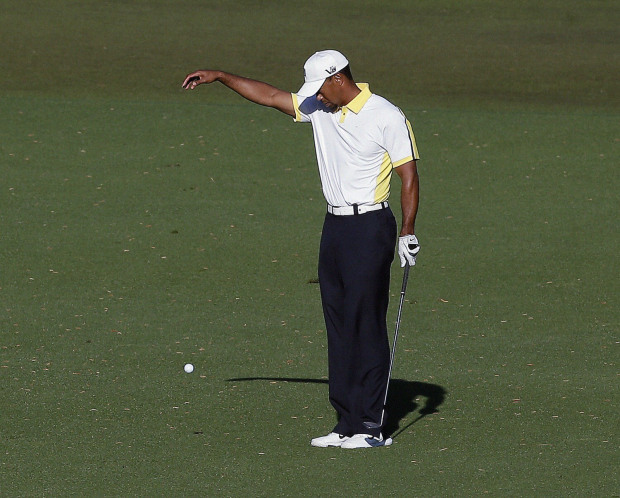TORONTO — It was a blustery Friday afternoon at Augusta National two years ago and, had his golf ball travelled an inch to either the left or right, you wonder how the world of Tiger Woods would have unfolded in the months since.
Amid all the post-mortems and eulogies offered in the past few days for the career of Woods, which was put on hold last week when he simply up and quit from a tournament at Torrey Pines, then announced that he would return at some unspecified time in the future, it was easy to overlook the fact that, as recently as April, 2013, he looked like Old Tiger again.
You may recall the occasion. Woods had opened the Masters on Thursday with a round of 70 that left him four shots off the lead. Then he watched, from the comfort of the second-last group, as the leaders — Sergio Garcia, Dustin Johnson, Marc Leishman — all took turns blowing up, allowing him to do boring Woods-in-a-major things and plod his way into a tie for the lead. Then, after two good shots on the par-5 15th hole, a great shot — a perfectly struck wedge approach — hit the flagstick dead square, sending his ball rolling off the green into the water. He made bogey, dropping him out of the lead. That eventually turned into a triple bogey after Woods was assessed a two-stroke penalty for botching his drop on 15 before his Saturday round began.
Having hit that shot from that spot to that pin, Woods probably makes birdie 99 times out of 100. Maybe less than that because one or two would have spun back into the cup for an eagle. But the point is: if not for that crazy bit of luck, Woods almost certainly goes to the 16th tee with the sole lead at the Masters. It was essentially a four-shot swing. He would finish four shots out of the playoff won by Adam Scott. Woods would have had plenty of time to blow a late-Friday lead, of course, but it’s not hard to imagine him closing the deal. The Woods of 2013 was a pretty good version of the much younger, dominant one. Finally healthy and seemingly at peace with his golf swing, he had won three times coming into the Masters, and would win twice more that year, including a month later at the Players Championship. The only thing that plagued him was his drought in major championships. If he had broken the streak at Augusta that year, would we today be looking at a Woods who is lost in the golf wilderness? (Since we’re piling on the hypotheticals here, it’s worth nothing that Woods folded twice on the weekend in subsequent 2013 majors. Would a Masters win, and all the pressure it would have relieved, have prevented that shaky late-round play at the U.S. Open and the Open Championship?)
The question is all the more relevant since no one, save Woods himself, believes that his current problems — a missed cut and a career-worst 82 at Phoenix followed by the 11-hole withdrawal in San Diego — are related to technical issues with his swing or his short-game mechanics. Woods, once possessed of the best head in golf, by some distance, is now missing fairways by the length of his yacht and skulling chip shots like he is trying to hustle someone into a back-nine press. He looks beset by problems of the mind, no doubt exacerbated by the winless streak in majors that is approaching seven years. Among those who have diagnosed Tiger with a severe case of the heebie-jeebies is analyst Ian Baker-Finch, the former Open champion who said Woods was playing with “fear,” and likened his anxiety to that which derailed his own playing career. This is a rather alarming statement to be coming from Baker-Finch, who once stood on the first tee at St. Andrews and snap-hooked his drive halfway to Edinburgh. The man knows the yips.

But Woods seems like he would rather poke his eyes out with a bunker rake than admit to mental struggles, a by-product of his game having been forged in the Earl Woods blast furnace. Look back at all the stories that were written during his decade of dominance about Tiger’s formative years, and the fact that his late father drilled mental toughness into him at a young age is a central theme. Earl made Tiger into a Marine who played golf. The iron will served him well for a long time, leading to the records that have been repeated so often as to become familiar: 14-1 when leading after 54 holes at a major, 54-4 with at least a share of the 54-hole lead on the PGA Tour, 11-1 in PGA Tour playoffs and another 10-0 in playoffs on the European Tour. Pressure was his thing. The best closer ever. His peers knew it, too. Justin Rose, after Woods won at Bay Hill in 2013 prior to the Masters, said that Tiger was so used to attention and big moments, that “Sunday is a lot less pressure” for him. Everyone else had to adjust for the atmosphere, had to find a way to be comfortable in it, but for Woods it was just his normal routine. You could beat Tiger off the tee or on the greens, but you could not beat him in the mind.
That’s what makes the Woods wobbles of the past few weeks so different than the post-2008 ups and downs that can be attributed to any number of factors, from injury to age to fatherhood to infidelity. These things were bound to happen at some point. (OK, maybe not that much infidelity.)
But, a Tiger Woods without his greatest weapon? The mind reels.



